This is the second story in a series on covering violent conflict in Latin America.*
No reporting assignment is the same when it comes to coverage of violent conflict or violent areas. Every situation seems to have an unpredictable component.
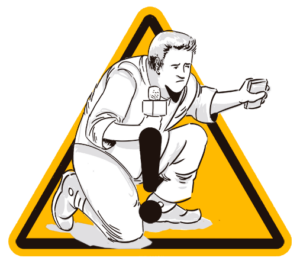
(Illustration: Pablo Pérez "Altais")
This is according to several journalists and experts from Mexico, Brazil, El Salvador, Venezuela, Ecuador and Colombia interviewed by LatAm Journalism Review (LJR), and who have experienced the mercurial nature that violence can sometimes have in parts of their countries.
Stories about gangs and criminal organizations, border areas with the ambiguity of their limits and jurisdictions, marginal urban towns or a simple central plaza of a city taken over by drug cartels are some of the Latin American topics and scenarios where journalists of the region can find their best reports or a life-or-death situation. Although it’s not a traditional war, the conditions and preparations are not so dissimilar for members of the press.
Covering violent situations in risky areas
Salvadoran anthropologist, cronista and columnist Juan Martínez d'Aubuisson, whose texts are published by El Faro, Insight Crime, Revista Factum, Gatopardo, among others, documents social violence in northern Central America.
For years, Martínez has frequently gone to the Rivera Hernández neighborhood of San Pedro de Sula, in Honduras, where various gangs such as Barrio 18 and one of the largest criminal structures in Honduras, Mara Salvatrucha, coexist.

On the left and wearing a blue shirt, Salvadoran chronicler Juan Martínez d'Aubuisson in El Salvador, together with ex-members of the MS13 and Barrio 18. (Courtesy)
“The violence is so intense [there] that the gangs, sometimes the new gangs, are wiped out relatively easily. So, I was trying to document and describe what the birth of a gang is like in that neighborhood,” Martínez said.
On one of his trips to Rivera Hernández, towards the end of 2018, and after spending several weeks with one of the new gangs, made up of young members, Martínez witnessed a confrontation between the new group and members of the Mara Salvatrucha.
The encounters between gangs in general are very strong, Martínez said, but what was different about that time was that the gang of young people ran out of ammunition and started launching Molotov cocktails from a roof. That is, bottles with gasoline and a lit rag as a fuse. At that uncertain moment, “I was absolutely convinced that I was going to die,” Martínez confessed.
Fortunately, he was able to live to tell about it, and it was not the last time he visited that neighborhood, nor that convulsive region of Honduras.
Martínez acknowledges that this is not the most traditional way of covering violence, which is why he does not recommend the way he works to anyone. “Once the violence starts, there are no fixed protection protocols.”
In his opinion, for this type of coverage, it is good to have some kind of physical preparation. A very good protection option is to know some kind of self-defense technique or martial arts, "like the great teacher [and Peruvian journalist, Gustavo] Gorriti." It is also useful, during armed confrontations, to wear dark clothes, always keep moving and be well identified by the group you are accompanying. Another essential aspect is to maintain communication with a trusted contact, or monitor, who knows where you are and what your situation is.
Covering ordinary events in violent areas
In some Mexican cities, such as Nuevo Laredo in Tamaulipas, near the northern border with the United States, even the most ordinary events, such as civic events at the town hall in the public plaza, can be scenes of potential violence.
As a reporter, Alberto Carrasco, head of information for the Nuevo Laredo newspaper El Mañana for six years, has covered diverse topics, such as security, politics, the environment, etc. On a daily basis, he experiences the latent violence of Nuevo Laredo, as a journalist and as a citizen.
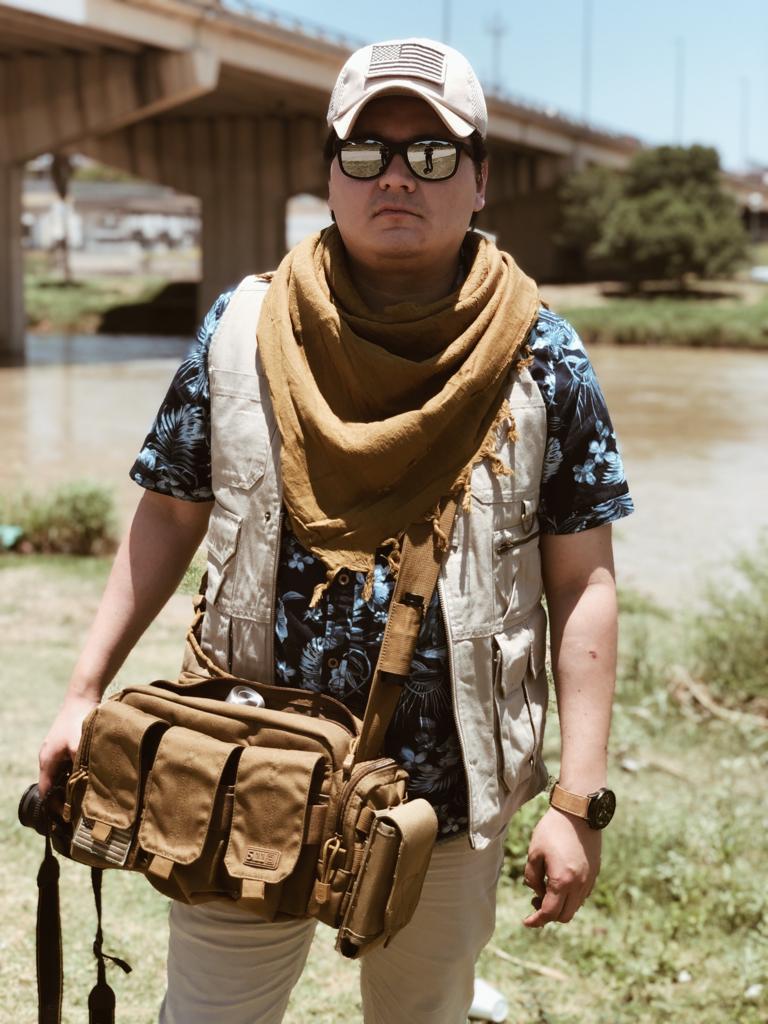
Mexican journalist Alberto Carrasco from the newspaper "El Mañana" of Nuevo Laredo. (Courtesy)
“Any reporter who has been reporting here for about ten years has gone to at least one or two training courses that include [techniques for] some coaching” on how to protect themselves, Carrasco told LJR, such as those sometimes offered by the International Center for Journalists (ICFJ).
On Jan. 25, 2018, Carrasco had to put all his knowledge of self-protection into practice when he was covering an official act of the then-mayor of Nuevo Laredo, Enrique Rivas Cuéllar, which was attended by more than 150 guests, including many children, who ended up throwing themselves to the ground to save their lives, according to Telemundo.
When the mayor was inaugurating a mural in the city, a gunfight broke out between criminal gangs a few meters away, causing everyone present to crouch down and seek shelter anywhere they could: behind statues, park benches, in gardens, etc. Carrasco said. The mayor’s security and members of the Army activated their defenses.
Journalists are now more accustomed to this type of event, Carrasco said, and the first thing to do in these cases is to protect yourself.
In cities like Nuevo Laredo, or in rural areas of Tamaulipas, any reporting assignment implies a moderate risk if proper precautions are not taken.
It is also good to ride with the windows down in the car to listen to the shootings, which are frequent, and to know which route to take, Carrasco said.
Journalists in Nuevo Laredo do not usually cover topics that could endanger their physical integrity.
Itzia Miravete, prevention coordinator for Article 19 Mexico, told LJR the freedom of expression organization considers coverage on certain topics to be risky: corruption and politics, human rights, security and justice, protests, elections, and issues related to the defense of land and territory.
"It is important that the government [of Andrés Manuel López Obrador] undertake a permanent campaign to recognize the work of journalists to improve the perception of citizens towards the press," Miravete said. "On the other hand, this must be accompanied by curbing the stigmatizing discourses that are generated from the three levels of government against the press."
You don't enter militia zones (but, favelas, yes)
Mauro Pimentel is a Brazilian photojournalist and correspondent for Agence France Presse (AFP) in Rio de Janeiro, Brazil. Most of his reporting documents the lives of residents of Rio's favelas, which many prefer to call communities or neighborhoods.
Pimentel told LJR that he always avoids being the first reporter on the ground when it comes to covering violent events, such as clashes between gangs or with the police.
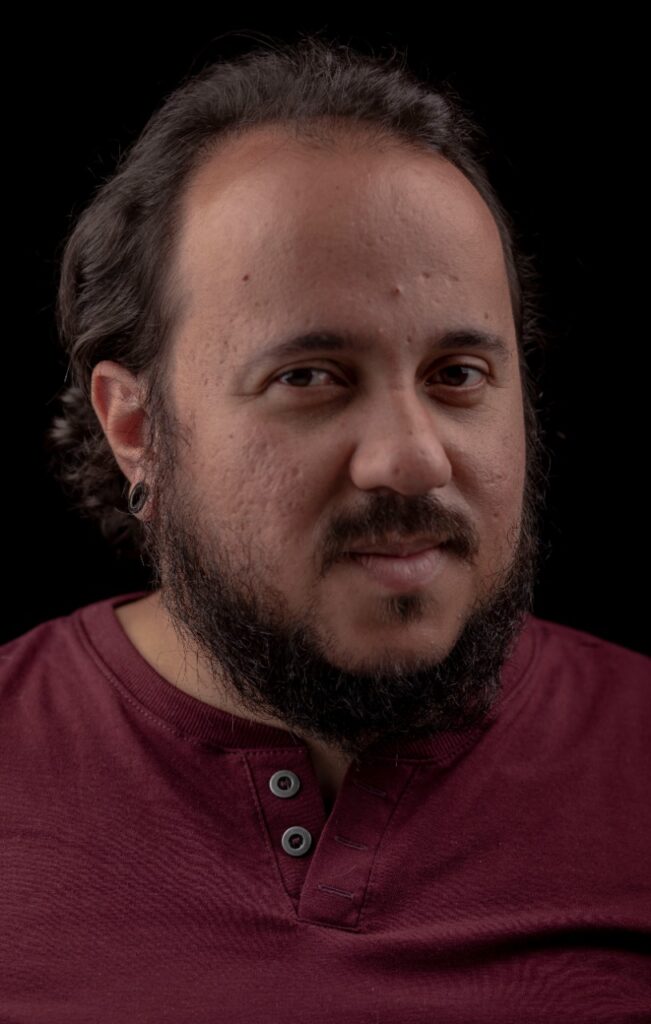
Mauro Pimentel, AFP photojournalist based in Rio de Janeiro. (Credit: Douglas Shineidr)
“In Rio, we have a lot of communication between photographers, for example, and even between reporters. So, always when you have big breaking news, you are never alone,” he said.
When it comes to reporting in favelas that Pimentel frequently visits, he dares to take more risks because he already has known contacts, sources. But, it always depends on what situation he has to cover and it is best to enter the area with other reporters.
“I always try to get in touch with [someone] local. But, when I first step foot in a place, the first thing I'm going to start to do, like small talk with anyone in the street just to try to understand the scenario,” he said. “And I think it's the way I like to be friendly, to be accessible, to explain what I am doing in that place and have people from the ground and from the scenario giving you access, helping them to understand why this guy came in with a big camera.”
Pimentel always tries to maintain constant communication, sharing his location by phone, with his editor and with the driver who accompanies him and waits for him at a safe point. The good thing about covering events within the city is that he always has a phone signal for communication.
A few days ago, he had to cover a shooting in the Vila Cruzeiro favela, where eight people died. Police had raided the neighborhood, saying they were targeting drug traffickers from a nearby favela.
In early February, the Brazilian Supreme Court voted to make the Rio government create a plan to reduce lethal violence from police in the city’s favelas.
Reporting only while there is daylight is another of Pimentel's prerequisites. One morning, when he was covering a Corpus Christi procession in the Rocinha favela, before they began to walk and while people were preparing for the rite, a shootout broke out between gangs. He took refuge in the house of one of the residents, who received him. They all waited for the shooting to pass and then continued with the procession. “Once you enter the favelas, everyone already knows that you are there. They spread the word."
One place where Pimentel never covers stories is in the areas or favelas controlled by militias, which are made up of gangs of ex-police officers, and sometimes, even current police officers.
“In those places, there is no negotiation. The media is not allowed. And that's it.”
LJR contacted the Military Police of the State of Rio de Janeiro, but did not receive a response as of publication time.
When the authorities are not the best contact
As a common practice, journalists who are getting ready to travel for the first time to a rural or border area to do a story often contact and introduce themselves to local community leaders, pastors of local churches, school teachers who have influence with the people, the authorities and law enforcement agencies.
At the end of March 2021, a team of journalists from Colombian media outlet NTN24 discovered the exception to the rule in Venezuela when they were detained after identifying themselves with the command posts of the area where they went to report.
Venezuelan journalist Luis Gonzalo Pérez, an international correspondent for NTN24, had gone with his colleague Rafael Hernández to do a week-long report in the eastern Venezuelan state of Apure, which borders the Colombian department of Arauca. The idea, Pérez told LJR, was to cover the displacement of thousands of Venezuelans to the Colombian side due to violence unleashed by clashes between the Venezuelan military and Colombian guerrilla factions.
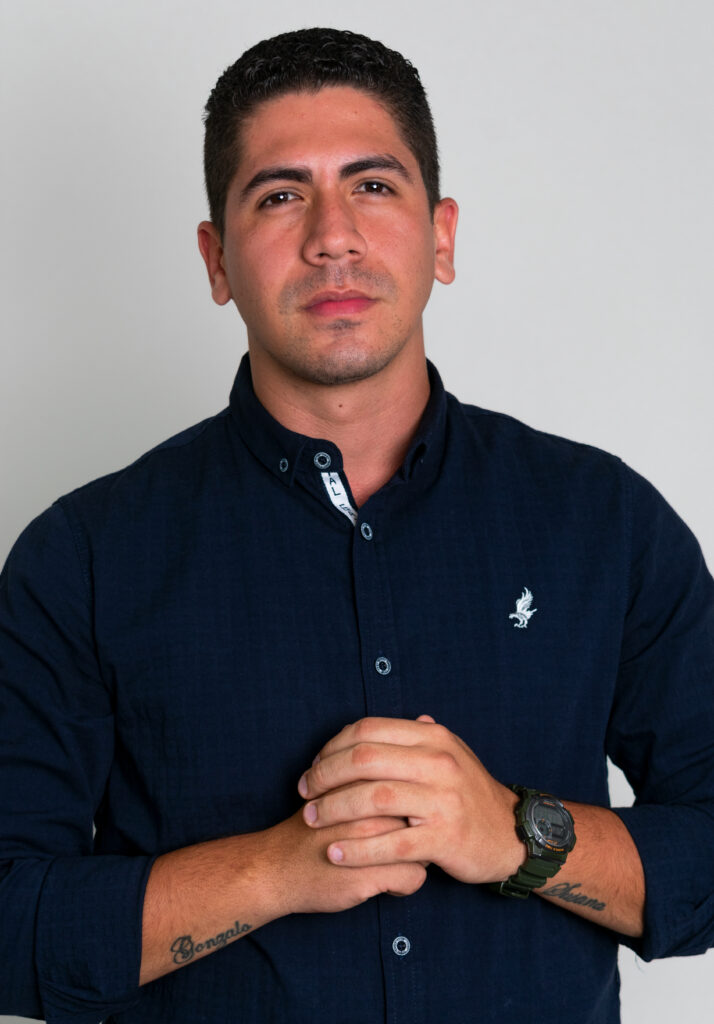
Venezuelan journalist Luis Gonzalo Pérez, correspondent of NTN24 of Colombia. (Courtesy)
They went from Caracas to Apure, on a twelve-hour trip by highway, because air travel was not authorized due to the COVID-19 pandemic. They managed to cross to the Colombian side to interview families who had migrated fleeing the violence, and then returned again to the Venezuelan side to continue their reporting. When they went to request authorization from the command of the Bolivarian National Guard (GNB) in the area to carry out their report, they were detained, Pérez said.
We identified ourselves and “we showed our press credentials to the soldiers,” Pérez said, but they still ended up in a detention room of the GNB command for almost 48 hours, where, according to Pérez, they slept on the floor, were held incommunicado, and were only given food once, an arepa and a coffee. They took away their belongings, cell phones, money, and their equipment along with all the journalistic material they had produced thus far.
Before their cellphones were taken away, Pérez said, he managed to communicate with his editor in Caracas and tell her that the situation was very suspicious because they were taking photos of them and asking for a lot of information. Pérez and Hernández were accompanied by a driver and two people from the organization Fundaredes.
“They put armed guards outside the detention room and from then on the mental torture began (…) They ignored all our requests for communication,” Pérez said. "It went on all night (...) and we heard about 70 mortar detonations outside the command, shaking the place," he added.
In those days, Diosdado Cabello, a Venezuelan assemblyman and number two of the Chavista party in Venezuela, called all the journalists who cover the border conflict in Apure "enemies." During his open-air program, he said that the journalists who go to that conflict zone are not going to cover the news, but to "sow hatred."
On Twitter, Colombian President Iván Duque rejected the detention of the journalists by "forces of the Venezuelan dictatorship," and called for the intervention of international organizations. The journalists were released the following afternoon, according to Pérez, leaving the GNB command with only the clothes they were wearing.
“It was an act of intimidation, intimidation and robbery. It was a crime,” Pérez said.
In a statement from the Bolivarian National Armed Forces about the clashes on March 31, 2021 in the border area of the Venezuelan state of Apure with the Colombian Department of Arauca, the presence of the press at the scene is mentioned.
"It should be noted that while the residents of La Victoria [in Apure] return from Arauquita [Colombian city] to their homes, it is observed how the operators of the canalla mediática (roughly, media villain) deploy their dirty manipulations to stoke violence in Alto Apure," the statement reads.
LJR tried to contact the Bolivarian National Guard, but did not receive a response as of publication time.
Between borders, without the law
On March 26, 2018, journalist Javier Ortega, photojournalist Paúl Rivas and driver Efraín Segarra of the newspaper El Comercio of Ecuador were abducted between the border of Ecuador and Colombia by a dissident group of Colombia’s FARC known as Oliver Sinisterra Front.
The leader of that dissident group, Walter Patricio Arizala Vernaza, alias "Guacho,” allegedly ordered the abduction and subsequent murder of the journalistic team, after the failed negotiations held with the governments of Colombia and Ecuador to free the journalists.
The journalists had gone to report in the Mataje area, in the Esmeralda province that borders Colombia, in northern Ecuador, to investigate the armed attack that killed three Ecuadorian Marines on March 20, 2018.
Since the end of 2017, and within the framework of the peace agreements between the Colombian government and the FARC guerrillas, the border area between Ecuador and Colombia has been affected by armed attacks, according to the report of the Special Monitoring Team (EES) of the Inter-American Commission on Human Rights (IACHR), which was in charge of the investigation of the abduction and murder of the Ecuadorian journalists.
“Javier was one of my most experienced reporters,” Geovanny Tipanluisa, then-security and justice editor of Ecuador's El Comercio newspaper, told LJR
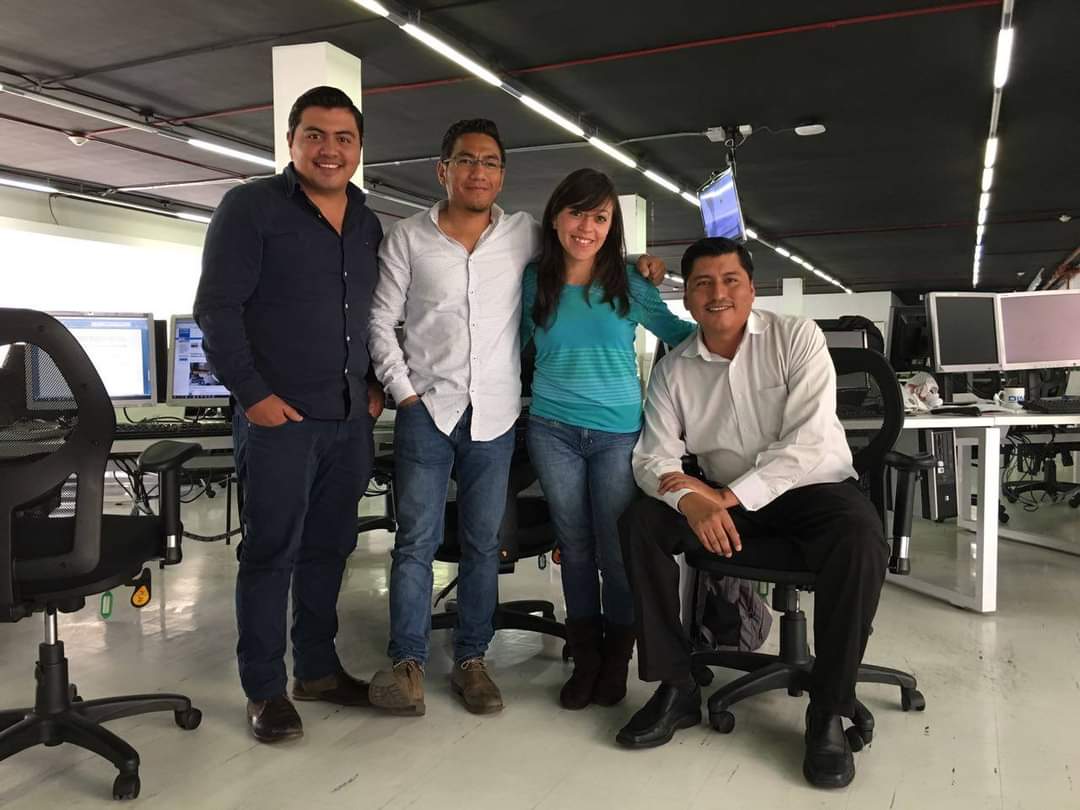
Javier Ortega (second from the left) and Geovanny Tipanluisa (seated to the right) in the newsroom of El Comercio, Ecuador. (Courtesy)
According to Tipanluisa, Ortega had been reporting in the border area of Esmeraldas province since 2013, including coverage of the last FARC armed convention in the mountains of Colombia, in 2016.
When on Thursday, March 22, 2018, they had the editorial meeting to determine what reports to do, it was decided that Ortega would go to Mataje. "Javier jumped up and said, 'Okay! I'm going to the border!'" Tipanluisa said. Before saying goodbye that day, the editor said, Ortega told him that this would be the best report of his life.
“We produced human stories of the people, and how they were experiencing that situation of violence. We always prepared ourselves,” Tipanluisa said. “One of the security measures was, first, to make contact with the leaders of the town, with the church, with the teachers, with the military or with the police, so that they protect us. So, that's what we always, always applied when the guys left; and to be in permanent communication, by call or by WhatsApp.”
For this reason, on March 26, 2018, when neither Ortega nor Rivas answered the calls or the messages, Tipanluisa and his editorial team began to worry. Tipanluisa had also gone in those days to report in the north of the country, near the border, in the province of Sucumbíos. When he contacted the director of the newspaper, he told him that it seemed there was an abduction.
On April 13, 2018, Ecuadorian President Lenín Moreno confirmed the death of the journalistic team of El Comercio. What "Guacho" had asked for during the negotiations with the governments of Ecuador and Colombia to free the journalists was to exchange them for three prisoners and to terminate the binational anti-drug agreement.
"The feeling of insolence, I could say, on the part of the States [of Ecuador and Colombia] in the face of the situation, was something that was causing us discouragement and fueled the idea that the outcome could be what it finally was," Jonathan Bock, director of the Press Freedom Foundation (FLIP) of Colombia, told LJR
Bock pointed out that at the official level there is still no satisfactory investigation into the abduction and murder of the journalists. “It is a case that has not advanced in terms of justice,” he said. The report Frontera Cautiva, by Colombian and Ecuadorian journalists, on what happened on the border is one of the most reliable investigations of the events, Bock said.
The “hard-hitting” occurrence of the abduction and murder of the El Comercio journalists “confronted us with the reality that Ecuador is experiencing a tremendous security crisis” due to organized crime, César Ricaurte, director of Fundamedios in Ecuador, told LJR
The murder of journalists has been a constant reason for Fundamedios to fight for security and protection mechanisms for journalists to be activated in the country, Ricaurte said, and for guidelines for security forces for the protection of journalists to be established. Ricaurte lamented that there is currently no response from the State to the constant attacks and threats by officials, security forces and organized crime against journalists in Ecuador.
The pandemic has made it more difficult to establish a dialogue with government authorities and institutions, such as the Ministry of Communication, Ricaurte said, to which Fundamedios has been proposing training for public servants on issues of freedom of expression, which has yet to materialize.
Journalists in Latin America reporting on violent conflict, whether involving organized crime, drug cartels gangs or members of the armed forces, must be prepared for the unpredictable, as these cases in Mexico, Brazil, El Salvador, Venezuela, Ecuador and Colombia have shown. In the following installment of this series, we will look at advice and tips from journalists and security experts with experience in these situations.
Credit banner: Mauro Pimentel/AFP*
*This is the fifth report in a project on journalist safety in Latin America and the Caribbean. This LatAm Journalism Review project is funded by UNESCO's Global Media Defense Fund.
Read the rest of the articles in this project at this link.
